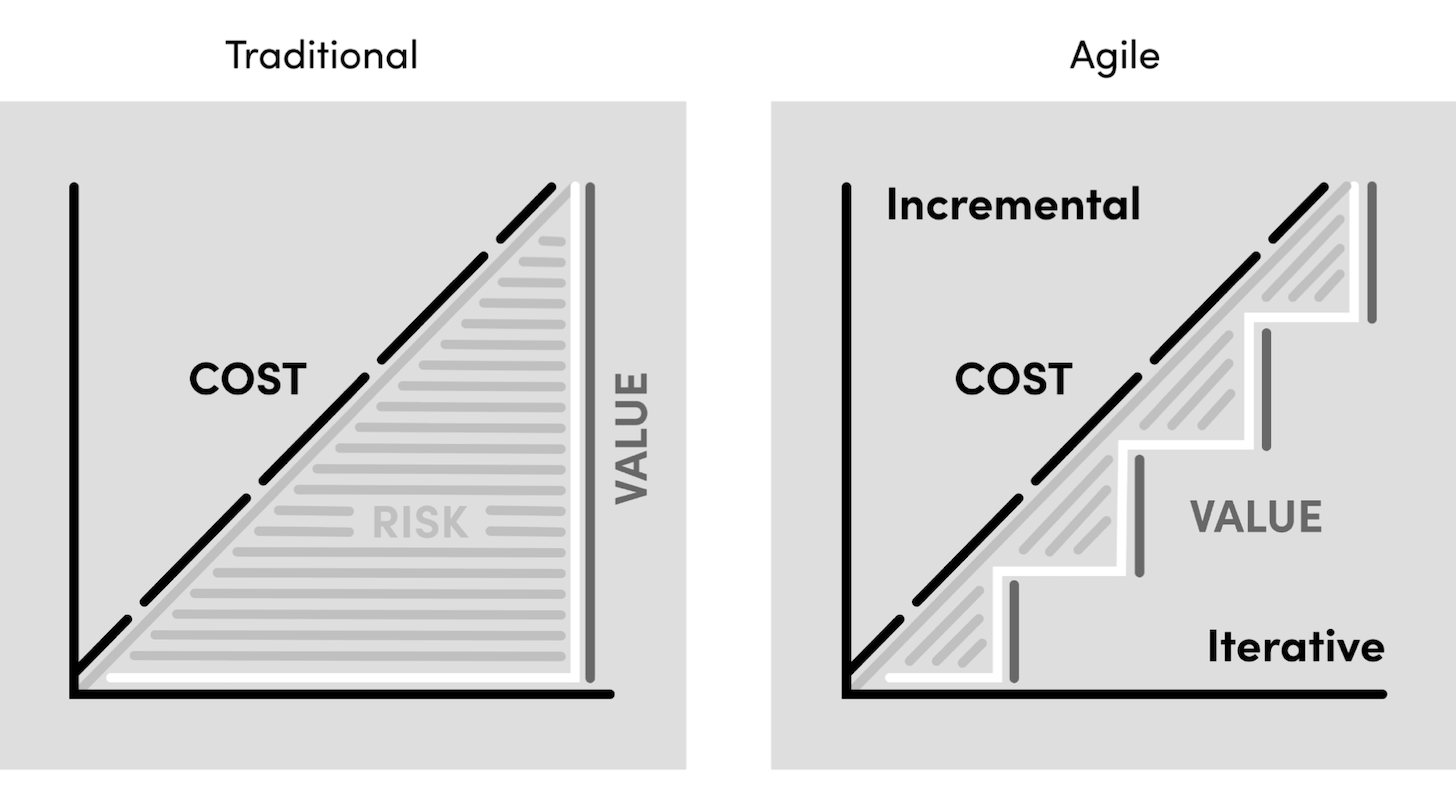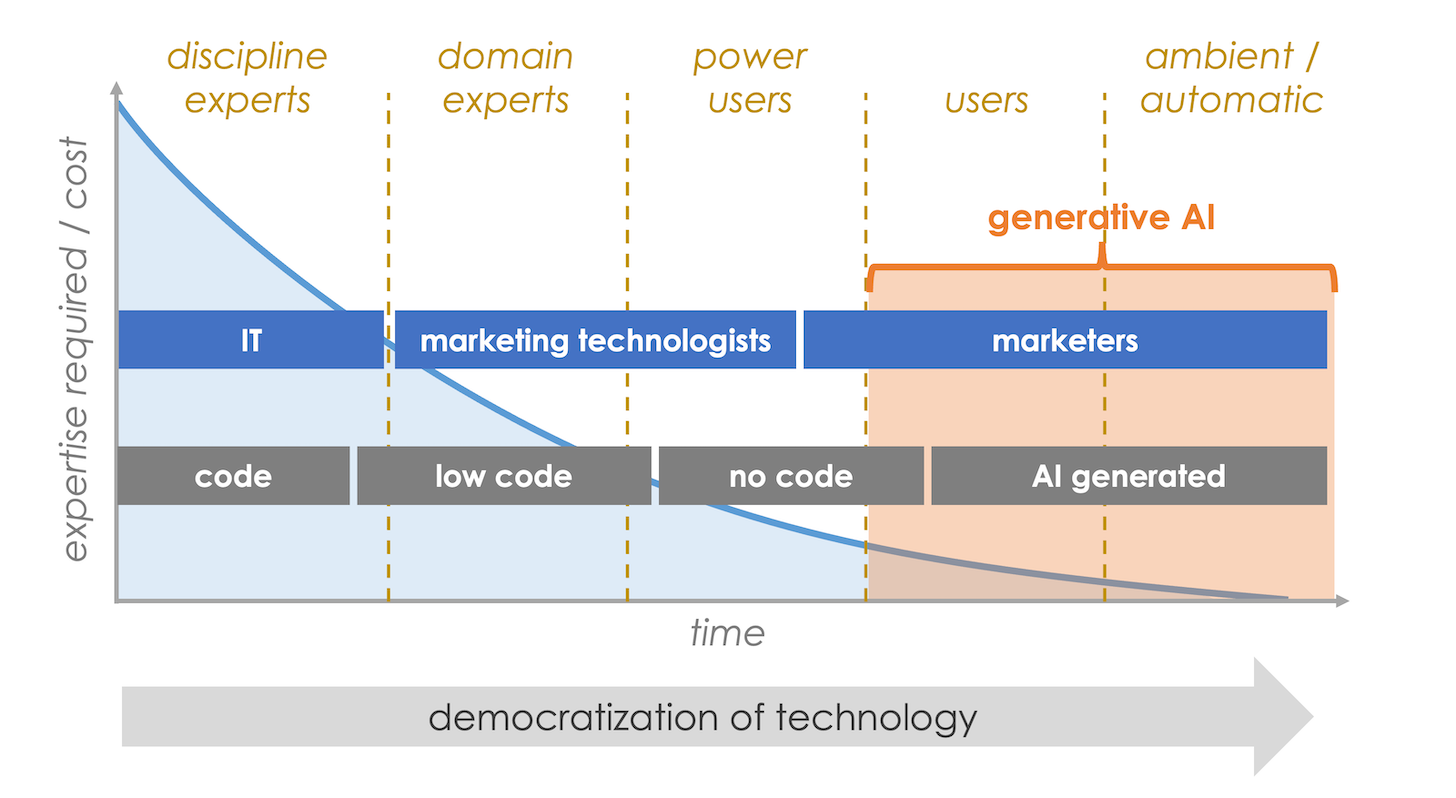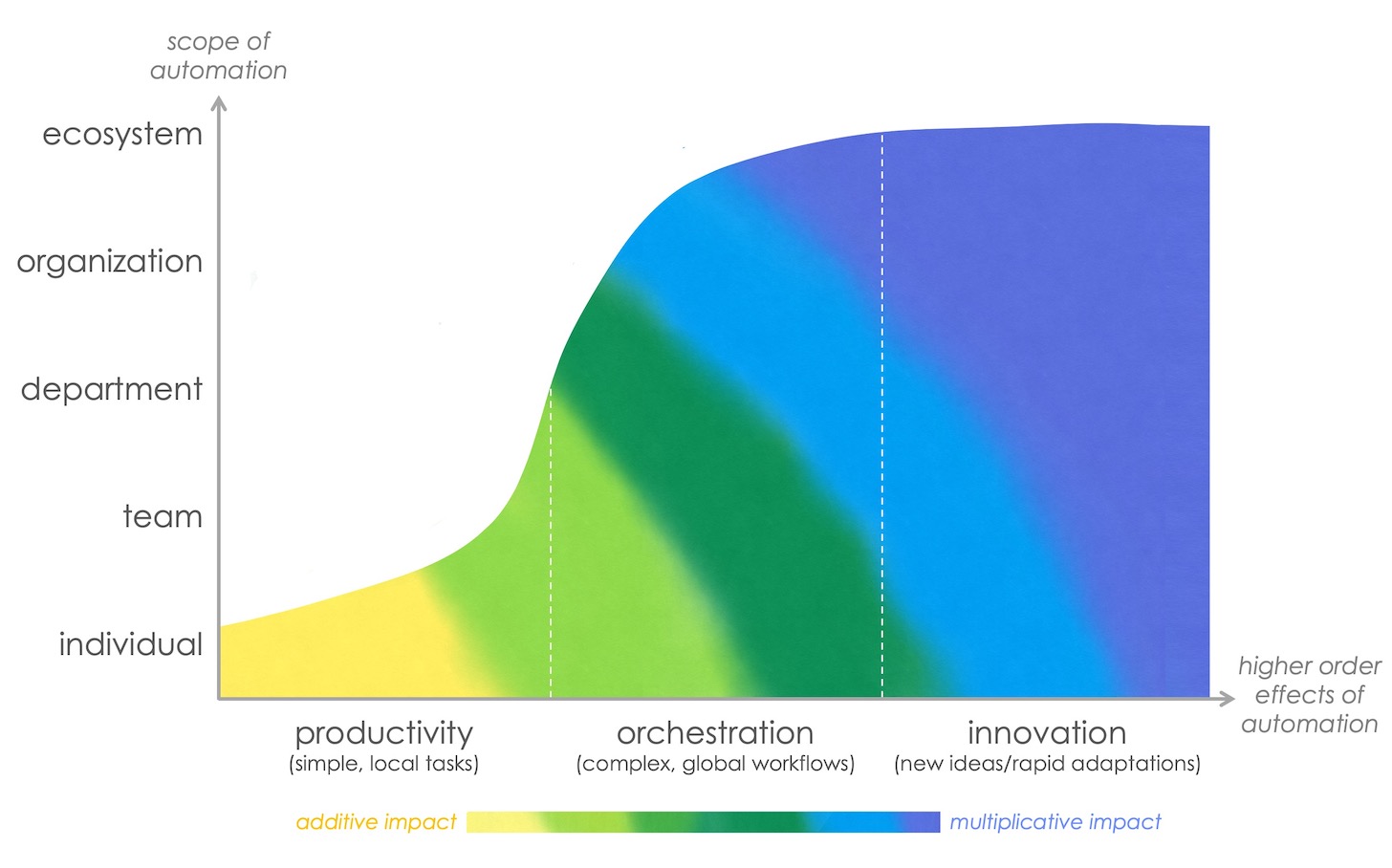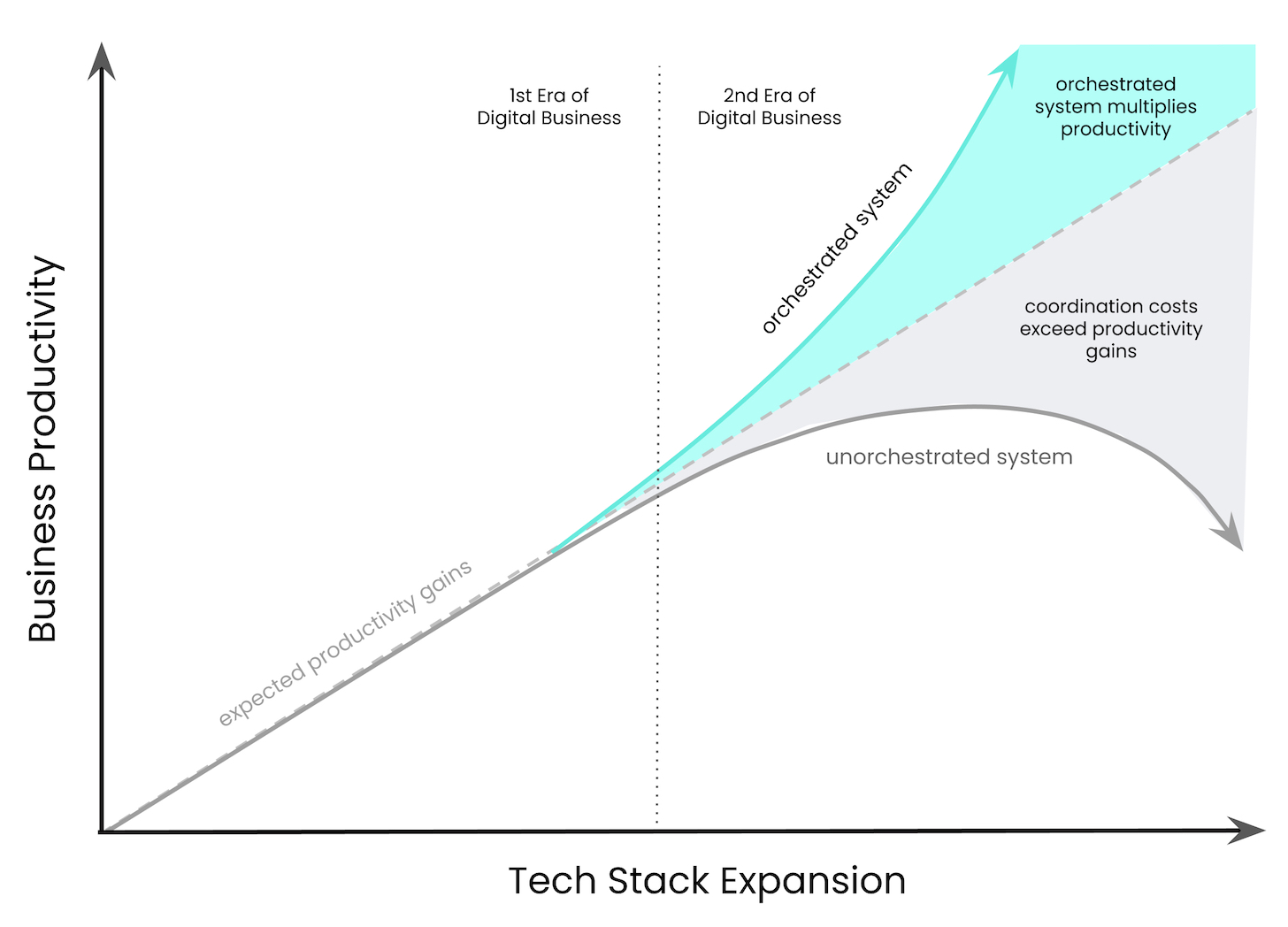[ad_1]
I’m excited to announce a new book coming out this summer, The New Automation Mindset: The Leadership Blueprint For An Age When Anyone Can Automate Anything With AI. Written by Vijay Tella, CEO of Workato, with contributions by Massimo Pezzini and myself, it offers a framework for harnessing automation as an engine of innovation, not merely efficiency.
When you think of automation, what comes to mind?
Most people would say automation is having a machine perform a task that otherwise would have been done manually by a human. The key benefit is efficiency. We automate tasks that a machine can do more quickly, more accurately, and more continuously. We automate tasks to save money by swapping labor costs with a fixed investment in a machine.
That definition isn’t wrong. But it is out of date and misses much of what’s now possible.
That view of automation is rooted in the Industrial Age. And while computers and robots have dramatically expanded the range of tasks we automate beyond classic manufacturing, the way we think about automation hasn’t advanced nearly as much.
We live in the Digital Age, but our approach to automation is often still anchored in the mental models of the Industrial Age. Fixed automations, dictated top-down, for a small number of high frequency tasks, rolling down a linear conveyor belt. It’s a factory mindset.
But we’re living in a time of interwoven digital ecosystems, both within our business and beyond our walls, that are more about highly networked interactions.
It’s more fabric than factory.
The biggest constraints we face in harnessing the full potential of automation today? Our own self-imposed limits of how to apply it.
Vijay, Massimo, and I wrote this book to give you a new automation mindset to break free of those limits, to instead offer a digitally-native view of automation that will help you out-maneuver and out-innovate your competition.
It’s framed by three new ways of thinking about automation.
Plasticity: A Growth Mindset
The most powerful difference between the physical and the digital is malleability. Atoms are slow and expensive to reconfigure. Bits, on the other hand, can be instantly rearranged, at near-zero cost.
We’ve inherited much of our current thinking about process management from the days when process was all about atoms. People and things moving in the physical world. We designed processes to optimize those moving parts. But since implementation of processes — or later changing those processes — was expensive, we didn’t think of them as particularly flexible.
In fact, the rigidity of a process was a feature, not a bug. “This is the process” were comforting words. Follow the process. Don’t deviate from the process. We eliminated variance. And that was — and still is — a benefit.
But variance and adaptability are two very different things.
Eliminating variance with a fixed, repeatable process gives us internal predictability. It’s like a deterministic function, such as y = x + 1. Every time you plug in x = 2 as the input to that process, you’ll get y = 3 as the output on the other side.
But it does nothing about external predictability, of which there’s very little these days. We are operating in an environment of rapid and continuous change, dramatically accelerated by AI. Technology, competitive dynamics, and — most of all — customer behaviors and expectations are continually shifting around us.
Whether those changes are a threat or an opportunity largely comes down to adaptability. How quickly can we adapt our business to new circumstances?
Adapting our business means changing our processes. It doesn’t work to have our old process of y = x + 1 take x = 2 and suddenly output y = 5. That would be chaos!
Instead, we need to swap out y = x + 1 with a different process. Maybe a slightly modified one, y = x + 3. Or maybe an entirely new one, with additional steps and multiple variables, y = 2x2 + 5z + 7. (Okay, no more math equations, I promise.)
We still want this new process to be as predictable as the old one. But the key is that it’s a new process that’s been adapted to new circumstances.
And here’s the beautiful thing: because almost all of our processes today are — or can be — digital or digitally-orchestrated, they are extremely malleable. It’s bits, more than atoms, flowing through them.
To harness the power of that malleability, you just need two things:
- The technical ability to reconfigure your digital processes on-the-fly.
- The willingness to make those changes at the speed the technology makes possible.
Modern enterprise automation software gives you the first.
The second is achieved by approaching process management with the same principles applied in agile software development.

Instead of once-and-done, big-bang implementations, we should approach process development as a living thing. Develop processes in a more incremental and iterative fashion. Use outcome-based feedback loops to guide ongoing improvements. Empower small teams to nimbly create and adapt process automation — both to optimize their own local workflows and to help shape global, cross-organizational ones.
Don’t resist change. Design for change.
The first way of thinking in an automation mindset: think continuous adaptation.
Democratization: A Scale Mindset
We often say that a business is its people. Their talent, drive, imagination, and heart are what brings a business to life. Human capital is by far the most precious capital we have.
But when you think about it, it’s more accurate to say that a business is its processes.
Processes are how our people interact with each other, with our customers, with our partners. Processes are the means by which individuals come together as teams, teams come together as companies, and companies come together as ecosystems.
People are the who in our business. They’re the crucial source of our what and why.
But process is our how. How our people work together. How they engage with customers.
Any collaboration between two or more individuals inherently has a process. Now, that process could be intentional or improvised. It could be reliable or erratic. It could be fast or slow. It could be enabling or constricting. It could be delightful or frustrating. But it is a process.
A business consists of thousands — even millions — of such processes, small and large. Collectively, these define how the business operates. And in turn, this determines the experiences its customers and employees have. The sum of these processes really are the business.
Recognizing this leads to two conclusions.
First, process is the way we harness the talents of our people to deliver amazing experiences to employees and customers. Nothing is more frustrating to them than being stymied either by rigid processes that aren’t adapting to changing circumstances or by undefined “dark” processes that are improvised and inefficient, holding them back, tripping them up, dragging them down.
Second, the sheer number of all these processes makes it impossible to dictate them — much less optimize them — top-down. You must enable talented people throughout your organization to create and adapt the processes that they’re closest to. It’s the only way to address the first conclusion at scale.
And here’s where things get exciting.
The rise of low-code/no-code tools and now generative AI in enterprise automation has dramatically changed what talented people throughout your business can do. They can now create and automate digital and digitally-orchestrated processes, and they don’t have to be software engineers to do it.
These tools let business people express how they want a digital workflow to work through an intuitive, visual user interface or even a natural language chat UX. They can “program” a process to be automated — without having to know a programming language. These tools take care of the underlying technical mechanics for them.

These tools enable a much wider set of people to automate processes in their work. As a result, the total amount of automation in our business can grow significantly.
These automations can be implemented quickly and inexpensively — and continually be adapted — without getting bottlenecked behind other, unrelated teams and projects. And they can tap the specialized experience and expertise of the people who are closest to the work being automated.
It democratizes the power to innovate throughout your company. Nearly anyone with an idea for how a process can be automated and improved can bring it to life. And that’s empowering to teams of all sizes, in all corners of your business.
Instead of being stuck in a poor process, they can invent a better, automated one.
This democratized adaptability and innovation can be your secret sauce.
As venture capitalist and no-code pioneer David Peterson eloquently said, “When the person who feels the pain is also empowered to build the solution, the result is magical and utterly unique.” Enabling such bottom-up invention at scale, forged by talented individuals at all levels within your organization, lets you out-innovate your competition across hundreds and hundreds of processes, small and large.
But you’ve got to enable it and encourage it.
The second way of thinking in an automation mindset: think democratized invention.
Orchestration: A Process Mindset
Yet perhaps the greatest way in which automation differs qualitatively today is the ability we have to dynamically orchestrate processes that span many different tasks, teams, and systems.

You can still automate an individual task. But now you can also automate whole sequences of tasks, which combine together to perform larger functions. It’s like individual atoms bonding into bigger molecules, and those molecules coalescing into complex objects and lifeforms.
This is possible because essentially all of the apps and services we use today can be controlled through APIs in the cloud. Or, for legacy software that doesn’t have an API, we can deploy AI agents that simulate human inputs and outputs — and then control those AI agents through an API. (This latter approach has been known as robotic process automation.)
Picture every function in each of your apps and services as a little digital Lego block. With an AI-powered automation platform, you can assemble any combination of those Lego blocks into any process you can imagine.
Like Lego blocks, you can rearrange them any time. You can embrace continuous adaptation.
Like Lego blocks, almost anyone can build things with them using a low-code/no-code or natural language AI interface. You can enable democratized invention.
But the truly giant leap forward is that you have complete freedom to assemble these digital Lego blocks in any pattern you want — regardless of which apps or services they reside in.
You’re not restricted by the boundaries of an individual app.
You’re not restricted by the boundaries of teams or departments either.
For that matter, you’re not even restricted by the boundaries of your firm.
You can mix-and-match any combination of functions, from any app or service, anywhere in your organization or beyond it. You can leverage any data, anywhere within your network, to feed into and control these assembled processes. You can synthesize workflows that aren’t simply linear. They can run multiple tasks in parallel at the same time. They can conditionally branch to different actions based on any decision logic you want.
It’s more than automation. It’s orchestration.

For example, consider everything that’s required to onboard a new employee. Add them to your HR system. Get agreements signed and filed with legal. Set them up on your payroll service and arrange direct deposits for them. Configure a new computer and get it delivered. Program their access badge and their single sign-on credentials. Create their email account. If they’re working in sales, create an account for them in your CRM and assign them proper permissions. Queue up training sessions for them in your learning management system. Email them a welcome kit. Physically send them some groovy swag. Update employee directories and org charts. And so on, and so on, with different steps criss-crossing a wide variety of systems and departments.
All of that can be orchestrated through your enterprise automation platform. Some steps should be sequenced in a specific order. Others should happen in parallel to speed up the end-to-end process. A bunch of decisions need to be made along the way — as many as possible made algorithmically. The whole experience should be personalized and delightful for your new hire. And that process should run consistently, efficiently, and reliably for every new employee.
By orchestrating your whole employee onboarding process with enterprise automation, you also gain incredible transparency into it. Every step along the way is tracked. You know exactly which steps have been completed and when — and which ones still remain to be done. Everything is monitored for errors or exceptions, delays or deviations. Everything is instrumented to give you insight into its performance and opportunities for improvement.
Nothing falls between the cracks. In a complex, distributed process, that’s immensely valuable.
Employee onboarding isn’t the only thing that looks like this. Campaign operations in marketing. Quote-to-cash in sales. Case-to-resolution in customer service. Data pipelines and dashboards. Digital product development and deployment. The list goes on — and is expanding rapidly.
The more digital your business becomes, the greater need there is to keep all the different parts of your operations aligned and synchronized in real-time across traditional boundaries.
But this capability, once you have it, opens up a wide frontier for innovation. You can invent automated processes that go far beyond what was possible with their manual forerunners, unconstrained by any organizational or technological silo that may have been a hurdle in the past.
The third way of thinking in an automation mindset: think boundaryless orchestration.
Innovate the Future, Don’t Automate the Past
Continuous adaptation. Democratized invention. Boundaryless orchestration.
These are the pillars of an automation mindset that takes full advantage of what the technology is capable of today. It lets you apply automation as more than a tool for productivity. It becomes a tool for creativity.
Want the full story? Pre-order The New Automation Mindset: The Leadership Blueprint For An Age When Anyone Can Automate Anything With AI for August 29.
[ad_2]
Source link









